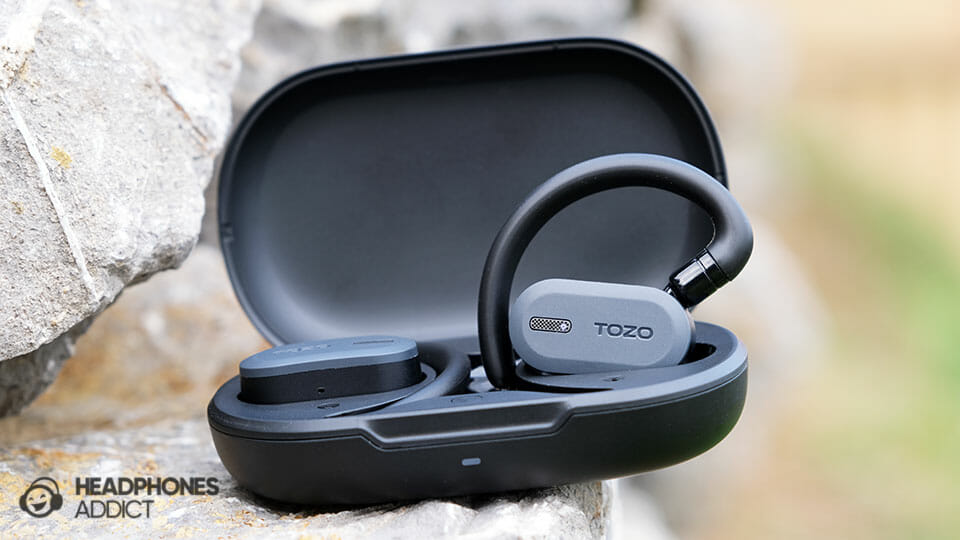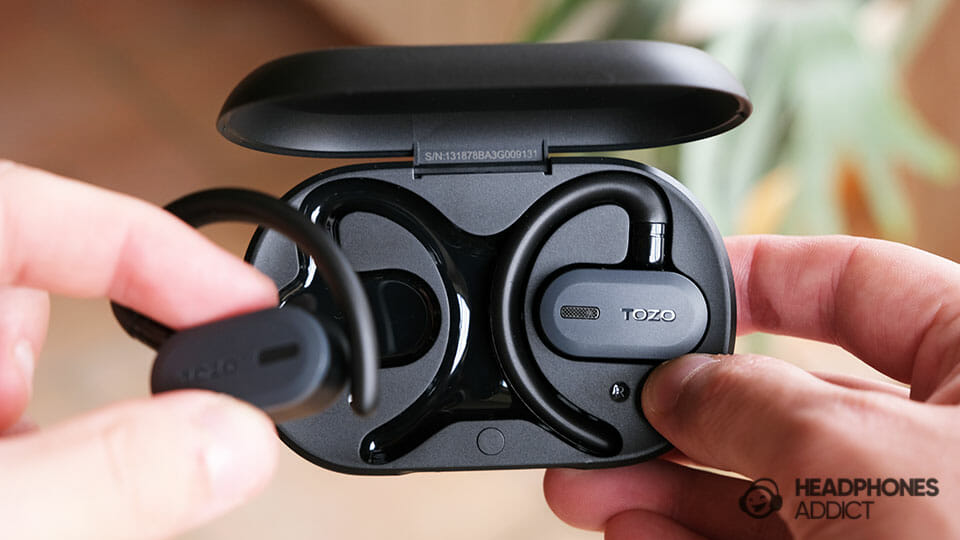
TOZO OpenBuds offer a unique take on sports earbuds with an air-conduction design. But forget the features that would improve the user experience, resulting in a half-baked product.
Similar to TOZO OpenReal, the TOZO OpenBuds are air-conducting true wireless earbuds for sportspeople. They let you hear everything around you while listening to music.
They’re a perfect solution for runners and cyclists due to increased awareness and excellent stability. The OpenBuds even improve on comfort compared to similar Skullcandy Push Ultra.
However, despite the higher asking price compared to the OpenReal model, they lack a custom equalizer, which would fix the thin and occasionally sibilant sound.
You’re left with a product that could’ve been so much better. Hopefully, TOZO addresses this thing via firmware updates.
Price:
Pros & Cons:
- Comfortable & stable fit with multi-angle ear hooks
- IPX6 rating is high enough for all sports except swimming
- Full surrounding awareness thanks to air-conduction design
- Long battery life at 7.5h, albiet not as advertised
- Great indoor Bluetooth range of 50 feet & multipoint
- Disappointing treble ruins sound quality
- No customizable audio equalizer
Category ratings:
Sound

TOZO OpenBuds have a full low-end and (sometimes) balanced midrange. However, treble is all over the place, making the sound unnecessarily thin and occasionally harsh.
TOZO has proven with OpenReal that they can deliver clear and full sound with air-conducting headphones. The OpenBuds are no different. They have a high potential for good sound.
However, the default tuning is less than optimal, “thanks” to a highly uneven treble. There are a few EQ presets in the app but no customizable EQ. And that’s a problem.
Let’s dig into bass, mid, and treble frequencies.
Bass: Full but not well extended or controlled
Bass sounds full and powerful enough to add punch and warmth to any music you’re listening to.
Lower frequencies have a respectable quantity and extension for air-conducting open-ear earbuds with drivers even further away from your eardrums than classic earphones.
That said, the extension and fullness still can’t match the bass from in-ear earbuds. And there’s no sub-bass rumble. You’d need noise isolation for that.
Furthermore, the bass control is less pronounced than in the OpenReal model. On the other hand, OpenBuds have better details and more nuance when listening to bass guitar.

Midrange: Sometimes balanced, sometimes thin
For the most part, midrange frequencies sound okay. In certain songs, vocals and instruments sound fine, albeit thin.
On the flip side, in many other songs, the boosts in the treble affect the tonality of the midrange, making vocals, in particular, very thin and sibilant. Guitars also lack energy, indicating a dip around 3-5 kHz.
Usually, we can show you a frequency response graph. However, we have difficulties making an accurate frequency response measurement on our MiniDSP H.E.A.R.S since the latter isn’t made to measure air-conducting headphones, only standard earbuds and headphones.
Treble: Very uneven and lacking detail
The main issue with TOZO OpenBuds is the tuning of higher frequencies. It’s highly uneven, with huge middle and upper treble boosts.
Highs can sound metallic, with poor detail retrieval and a lack of texture. Cymbal crashes have poor resolution and way too much sizzle.
If only TOZO would enable a custom EQ so you could try to fix this imbalance. The tuning contrasts entirely with the OpenReal, which have a much darker sound signature.
Moreover, all the extra 4 EQ presets you get in the app sound less than ideal, so we can’t recommend any.

On the other hand, the soundstage is big. More so than in the OpenReal model. It is deeper than wider, and you also get a good sense of sound playing “behind” you.
Interestingly, the imaging is also excellent. It is a bit blurry between the center and left/right image, but it is much more accurate than in many true wireless earbuds we’ve tested lately.
One thing worth pointing out is the static noise earbuds emit when playing music.
You can hear it right after pressing play, but you’re still waiting for the song to start. You can also hear it when listening to music at lower volumes and a few seconds after you press pause.
It is important to note that this isn’t an issue during sports activities, but it is still something we thought was a thing of the past. Even much cheaper earbuds don’t emit such noise anymore.

Overall, TOZO OpenBuds don’t convince us with their sound, especially after testing the OpenReal headphones, which sound fantastic (after customizing their EQ).
The latter is also the biggest problem of the OpenBuds: they need a custom EQ. And for $70, that is a very strange decision from TOZO.
Comfort & Fit

TOZO OpenBuds have a unique ear hook system and a cleaver design to ensure exquisite comfort and a secure fit. You can easily attach them with one hand.
TOZO OpenBuds use ear hooks to hold onto your ears, not ear tips. Despite their bricky looks, they gently lean on your pinna, avoiding poking or pain.
However, how you adjust the hooks is like anything I have ever seen. TOZO calls it “biaxial rotation” or “multi-angle adjustment”.

Ear hooks can rotate up to 100° left and right and up to 60° up and down. This up-and-down motion adjusts for the size of your ears and uses increments when adjusting. Increments produce clicky feedback.
That is an excellent solution to otherwise mouldable ear hooks that you need to constantly stretch and squeeze to fit your ears.
This brilliant design makes the OpenBuds very comfortable since the hooks don’t squeeze your earlobes and can fit just about every ear. Most importantly, it makes them extremely stable, too.
Earbuds didn’t move much during our head-shaking test, even when leaning the head in weird positions. We never managed to make them fly off our ears.
There really isn’t much else to say since TOZO did an excellent job here. The only hassle is that to place them back into the charging case, you must adjust the ear hooks to a specific size.

Are you looking for headphones for running or cycling? Here are some suggestions:
Durability

TOZO OpenBuds have an IPX6 rating, so you can use them in the shower. They’re built well, although the big and thin plastic of the charging case looks like it could easily crack.
Earbuds, while big, appear well-made. The housing is glued together from at least 3 parts, but it is impossible to crack it open without crushing it with something heavy.
The ear hooks are the only concerning part of the buds—particularly the multi-angle mechanism. However, while it has the potential to break, it would be hard to break it unintentionally.
Another point of concern are at least 3 openings protected with a fine mesh. The opening on the top reveals a glimpse of the 14.2mm dynamic driver inside.
That is where the IPX6 rating comes into place, as those protective meshes are fine enough to prevent water from entering. So earbuds can survive heavy splashes and a shower.

On the other hand, IPX6 is one rating short of confirming complete waterproofness, so avoid dunking the OpenBuds into water.
Strangely, earbuds aren’t rated for dust resistance since they’re ideal for all sportspeople, even outdoor runners.
About the charging case, it’s small in height but huge in width. Even wider than a credit card. It’s a bit clumsy.
That can be a problem since the plastic looks thin, especially on the lid. So, you should take good care of it, dropping is not advised.
Battery

TOZO OpenBuds have a real battery life of 7.5 hours, which puts them pretty high compared to other true wireless competitors. But that’s less than advertised. Also, the case doesn’t support Qi-wireless charging.
TOZO OpenBuds Battery Comparison

Big earbuds’ housing promised a larger battery and longer playtime. The result is still above average but not as high as expected. It looks like driving that 14.2mm driver isn’t easy.
Real battery life test:
In our battery life test, where we leave earbuds to play music at 50% volume, we got:
- Precisely 7 hours and 31 minutes.
That puts TOZO OpenBuds above the average in the true wireless category without ANC, but not among the best. Earbuds also perform worse than advertised, lasting 4.5 hours less (TOZO claims 12 hours per charge).
The big charging case holds another 30 hours of battery life, but it strangely doesn’t support Qi wireless charging (since it is so big and flat).
Furthermore, there are no mentions of the fast charging feature.
- Earbuds will charge from 0-100% in 1.5 hours.
Features

TOZO OpenBuds have a companion app but few features, especially for a $70 pair. Most notably, you can customize controls and use the buds in multipoint connection.
Some brands spoil users with tons of features even at around $50. We’ve come to expect the same treatment from all of them, including TOZO.

While TOZO Open Buds have a few notable features, they lack custom EQ, which would’ve greatly increased their value.
But first things first, let’s see what the OpenBuds do offer inside the TOZO app (apart from Bluetooth multipoint, which we’ll discuss later).
Customizable touch controls
The app covers all the most essential commands, so you don’t need to constantly reach for your phone.

Each command is freely remappable to whatever gesture you want. Except for the volume controls, which only works with a “long press” gesture.
You can occupy single, double, and triple click gestures on top of a long press gesture.
Sound Effects, aka. EQ presets
This time around, TOZO disabled the customizable EQ and only offered 5 sound presets or profiles. In other TOZO headphones, you get at least 16 presets.

Unfortunately, none of the available profiles (Bass+, Classical, Vocal, Treble+, and Standard) fix the unbalanced sound, so we can’t make any recommendations.
Soothing & relaxing sounds
Under the Explore tab in the app, you can find many audio clips, primarily meant as background music to help you relax or fall asleep.

Their length varies and can go up to 5 minutes per clip. To maintain a fluid audio playback, you must open the app’s music player and select to repeat the clip or jump to the next. Otherwise, the music stops when the clip is over.
It is worth noting that some clips refuse to play for some reason. It could be a regional licensing issue, but I find this unlikely.
Microphone quality
TOZO OpenBuds wireless earbuds offer a decent call quality in all environmental situations. Just know you sound very thin and quiet when talking to others.
Here’s a mic test:
TOZO OpenBuds microphone test: (no noise test from 0:00-0:29, with background noise test from O:29-0:54)
Like with any other headset, microphones inside the OpenBuds work best in quieter situations. They pick up your voice clearly so others can easily understand you.
The only downside is that you sound thin and quiet, so others might have to raise the volume to hear you better.

Moving into a noisier area makes your voice even thinner while adding some background distortion. Performance is still passable but not quite to professional phone call standards. So, it is best to avoid noisy places while having a conversation.
Noise Isolation

TOZO OpenBuds have zero passive noise isolation by design, but they do fairly well at handling sound leakage and suffer from minuscule wind noise, which is excellent.
Due to the air-conduction open-ear design which doesn’t block the ear canal, hearing ambient noise is one of the OpenBuds’ features. So, we’re ranking how well they manage sound leakage and wind noise.

Starting with leakage, there is some. But not as much as you might expect. At around 50% volume, people need to sit beside you to hear anything. You might even get away with using them in a library.
However, these aren’t exactly the loudest earbuds, so you might raise them to 60-70% volume, making them unsuitable for libraries.
Moving to the wind noise, you’ll be happy to know there’s very little of it despite the housing looking non-aerodynamic.
We made a quick test by running with and without earbuds to hear the difference in wind noise, and there was hardly any.
This makes them a great choice for cycling and running.
Bluetooth

TOZO OpenBuds offer a reliable Bluetooth connection with up to 60 feet of indoor range but more stutters than competitors. You also get Bluetooth multipoint for connecting up to 2 devices.
Earbuds use Bluetooth 5.3, which has proven to ensure stable wireless connectivity. You don’t get any audio stutters, even when there are many other wireless devices in the room.

Furthermore, OpenBuds do a good job maintaining their connection over long distances. In our indoor Bluetooth range test, we got:
- Up to 50 feet (15.2 meters) before we noticed the first audio stutter, but the music continued playing. That is right after passing the second brick wall.
- Up to 60 feet (18.3 meters) before the audio stopped playing.
That puts these earbuds above the average, meaning you can safely use them while walking around the house.
How to pair TOZO OpenBuds?
- You simply take them out of the charging case when pairing them for the first time. The pairing process starts when small LEDs on the buds start blinking.
- To pair them to a new device, place the earbuds back into the case and hold the physical button between the buds until you see blinking LEDs. That means they’re in a pairing mode.

TOZO OpenBuds also support basic Bluetooth multipoint. That enables you to pair them to 2 devices simultaneously.
- To do that, you individually pair them to 2 different devices following the instructions above.
- Then, first, connect them with one device.
- After, you enable Bluetooth on the second device and connect them to it as well.
Earbuds automatically select their audio source based on where you click “play”. They will also switch to your phone when you receive phone calls.
What Bluetooth codecs do they use?
TOZO OpenBuds have a standard selection of Bluetooth codecs, including SBC and AAC.
Is there an audio lag?
Earbuds show no lag when playing videos on YouTube or social media apps. In contrast, there’s a noticeable delay when playing mobile games.
Sadly, OpenBuds don’t have a Gaming mode, which makes them unsuitable for serious mobile gamers.
Should You Get TOZO OpenBuds?

TOZO OpenBuds are overall decent sports earbuds with fantastic comfort, stability, and reliable connection. However, while they exceed in functionality, they disappoint in performance.
What’s a better alternative?
We recommend TOZO OpenReal headphones more, they’re functional and also sound really good. And it is the latter where the OpenBuds model needs to improve.

We can still recommend these to intense sportspeople, like outdoor runners or cyclists, where less optimal sound quality doesn’t hurt the experience.
On the other hand, we can’t recommend them to users who want to use them for casual listening or anything besides sports.
How do TOZO OpenBuds compare to the competition?
- Compared to other open-ear headphones, they offer an equally stable fit but much better comfort due to the lack of the neckband arch.
- Around 7.5 hours of battery life makes them equally good as competitive true wireless earbuds, if not slightly better.
- Furthermore, OpenBuds have similar Bluetooth connection stability to other air-conduction headphones, with similar indoor range results.
- They can’t reach the same sound quality as some cheaper competitors.
- Earbuds have fewer features than competitors, which can at least customize EQ settings.
TOZO OpenBuds alternatives
TOZO OpenReal
You can change their dark default sound into an incredibly neutral one with the provided custom EQ, making them suitable for audio purists who want to workout with quality audio.
The battery is much better at 12 hours per charge but uses an annoying proprietary charger. Headphones are also fully waterproof, whereas OpenBuds only have an IPX6.
SoundPEATS RunFree Lite
While not the most detailed sound quality, you can get their tuning to sound better than OpenBuds, but with a tad less bass extension.
Headphones also support dual device connection and beat the TOZOs with their 20-hour battery life. Moreover, they have Game mode, which reduces latency and makes them suitable for mobile gaming.
Edifier TWS1 Pro 2
If you want something more “traditional”, TWS1 Pro 2 deliver a fuller and bolder sound without treble harshness.
Furthermore, they have a decent active noise-cancelling performance and a surprisingly stable fit for lacking ear wings. On the flip side, they only last for 4.5 hours compared to 7.5 hours from OpenBuds.
What’s in the Box?

- TOZO OpenBuds true wireless earbuds
- Charging case
- USB-C charging cable
- User manual
Specifications
| Type: | True wireless |
| Connection: | Bluetooth 5.3 |
| Back design: | Closed-back |
| Drivers: | 14.2mm dynamic |
| Frequency range: | 20-20.000Hz |
| Impedance: | n/a |
| Weight: | 0.35 oz (10 g) per bud, 2.7 oz with case |
| Mic & Controls: | Yes |
| Water resistance: | IPX6 |
| Battery life: | 7.5h + 30h in case |
| Charging time: | 1.5h – USB-C |
| Active noise cancelling: | No |
| Bluetooth codecs: | SBC, AAC |
| Wireless range: | 60 feet (18.3 meters) |
| Microphone: | DSP call noise reduction |

From a childhood fascination with sound, Peter’s passion has evolved into a relentless pursuit of the finest headphones. He’s an audio expert with over 5 years of experience in testing both audiophile and consumer-grade headphones. Quote: “After many years, I can confidently tell which headphones are good and which are terrible.” Find his honest opinion in his reviews.









